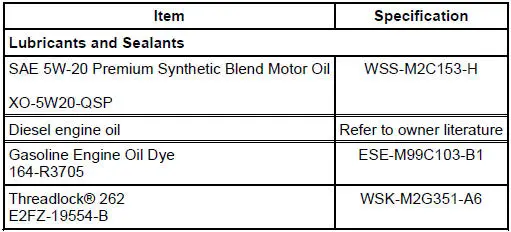Ford Mustang (1999-2004) Service Manual: Engine System - General Information
General Specifications

Engine
NOTE: This section contains information, steps and procedures that may not be specific to your engine.
This section covers general procedures and diagnosis and testing of the engine system, except for exhaust emission control devices, which are covered in the Powertrain Control/Emissions Diagnosis Manual.
The engine incorporates the following features:
- a closed positive crankcase ventilation (PCV) system.
- an exhaust emission control system.
- an evaporative emission control system.
Some engines incorporate a fail-safe cooling system. Refer to the appropriate section in Group for the procedure.
The engine, fuel system, ignition system, emissions system and exhaust system all affect exhaust emission levels and must be maintained according to the maintenance schedule. Refer to the scheduled Maintenance Guide.
Correct engine identification is required to order parts. Refer to the appropriate section in Group for the procedure.
For complete vehicle and engine identification codes.
- Engine (Diagnosis and Testing)
- Sprockets
- Rocker Arms - Inspection
- Push Rods - Inspection
- Camshaft Journal - Clearance, Plastigage Method
- Camshaft End Play - Push Rod Engines
- Camshaft End Play - OHC Engines
- Camshaft Lobe Lift
- Camshaft Runout
- Crankshaft Main Bearing Journal - Clearance
- Crankshaft End Play
- Crankshaft Runout
- Crankshaft - Connecting Rod Journal Taper, Out of Round
- Piston Inspection
- Piston - Pin to Bore Diameter
- Piston - Selection
- Piston - Ring End Gap
- Piston - Ring-to-Groove Clearance
- Piston - Pin Diameter
- Connecting Rod - Bushing Diameter
- Connecting Rod - Twist
- Connecting Rod - Bearing Journal Clearance
- Connecting Rod - Side Clearance
- Valve Stem to Valve Guide Clearance
- Valve Spring Strength
- Valve - Seat Inspection
- Cylinder Head - Distortion
- Cylinder Block Core Plug Replacement
- Spark Plug - Inspection
- Exhaust Manifold - Inspection
 Engine
Engine
...
 Engine (Diagnosis and Testing)
Engine (Diagnosis and Testing)
Special Tool(s)
Commercially Available
Leakdown Tester
Quick Disconnect Compression
Tester
134-R0212 or equivalent
Dial Indicator Gauge Adapter
303-007 (TOOL-6565-AB) ...
Other materials:
Lamp Switch - Headlamp
Removal
1. Disconnect the battery ground cable.
2. Remove the headlamp switch knob.
1. Pull the headlamp switch knob out.
2. Insert a thin tool into the slot, pull and remove the headlamp switch
knob.
3. Remove the instrument panel cluster fin ...
Climate Control System (Description and Operation)
WARNING: To avoid accidental deployment and possible injury, the air
bag system
backup power supply must be depleted before repairing any climate control
components. To
deplete the backup power supply, disconnect the battery ground cable and wait
one minute ...
Accelerator Cable - 3.8L
Removal and Installation
1. Push the accelerator cable nylon bushing out of the accelerator pedal and
shaft arm.
2. Remove the bolts retaining the accelerator cable to the dash panel.
3. Disconnect the accelerator cable from the throttle body by rotating ...
